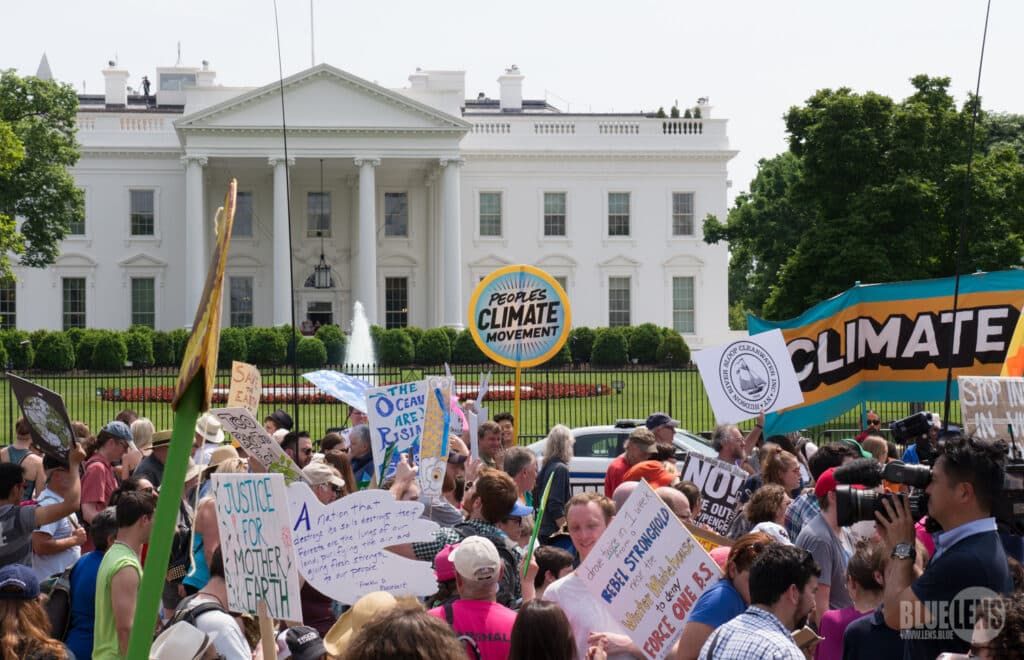There’s less need to convince people of a future climate doomsday. It’s already here.
By Jessica McKenzie | March 21, 2023
 A climate protest outside the White House in 2017. (Mark Dixon/Wikipedia, CC BY-SA 2.0)
A climate protest outside the White House in 2017. (Mark Dixon/Wikipedia, CC BY-SA 2.0)
The unfolding climate crisis was laid bare in the Intergovernmental Panel on Climate Change (IPCC) report released on Monday: Between 3.3 billion and 3.6 billion people live in places “highly vulnerable to climate change,” and from 2010 to 2020, “human mortality from floods, droughts and storms was 15 times higher” in these regions than in less vulnerable regions.
The report continued: “In all regions increases in extreme heat events have resulted in human mortality and morbidity (very high confidence). The occurrence of climate-related food-borne and water-borne diseases (very high confidence) and the incidence of vector-borne diseases (high confidence) have increased.”
In other words: Climate change is already killing people. And, the report makes clear, it will kill more.
Again, to quote from the report: “In the near term, every region in the world is projected to face further increases in climate hazards (medium to high confidence, depending on region and hazard), increasing multiple risks to ecosystems and humans (very high confidence). Hazards and associated risks expected in the near-term include an increase in heat-related human mortality and morbidity (high confidence), food-borne, water-borne, and vector-borne diseases (high confidence), mental health challenges (very high confidence), flooding in coastal and other low-lying cities and regions (high confidence), biodiversity loss in land, freshwater and ocean ecosystems (medium to very high confidence, depending on ecosystem), and a decrease in food production in some regions (high confidence).”
And yet, in spite of this stark and dire report, the topline message the panel of scientists led with in the press release, was “Urgent climate action can secure a liveable future for all.” Would one call that misleadingly optimistic? If journalists repeat that message, are they offering false assurances?
Two things can be true at once: The climate crisis is present and ongoing—and it can and will get much, much worse, unless the world sharply cuts greenhouse gas emissions.
A Harper’s Magazine cover story with the provocative title “The Incredible Disappearing Doomsday,” published on the same day as the most recent IPCC report, claims that the tone of climate reporters has become overly rosy over the past couple years. To illustrate this point, Kyle Paoletta quotes Washington Post reporter Sarah Kaplan, who wrote in August 2021, “Climate change is not a pass/fail course. There is no chance that the world will avoid the effects of warming—we’re already experiencing them—but neither is there any point at which we are doomed.”
This is realism, not unfounded optimism, and a close restatement of what scientists like IPCC author Claudia Tebaldi told Kaplan at the time: “The general conclusion is that every bit of warming matters in terms of creating outcomes that are different.”
The disappearing doomsday that Paoletta describes refers primarily to the one depicted in David Wallace-Wells’s 2017 New York magazine article (and later book of the same title), “The Uninhabitable Earth.” That, you might remember, was climate journalism at its most fatalist, especially Wallace-Wells’s assertion that “many sober-minded scientists” have concluded that “no plausible program of emissions reductions alone can prevent climate disaster.”
That does cut a striking difference to Wallace-Wells’s writing last year in the New York Times: “Thanks to astonishing declines in the price of renewables, a truly global political mobilization, a clearer picture of the energy future and serious policy focus from world leaders, we have cut expected warming almost in half in just five years… The window of possible climate futures is narrowing, and as a result, we are getting a clearer sense of what’s to come: a new world, full of disruption but also billions of people, well past climate normal and yet mercifully short of true climate apocalypse.”
In his Harper’s piece, however, Paoletta fails to demonstrate this violent shift to the positive occurred in climate journalism writ large. Indeed, Rebecca Solnit, whom Paoletta also quotes as an example of a recent climate optimism, responded on Twitter, “For the record, my climate coverage hasn’t changed (and I was never a climate catastrophist). I’ve been writing versions of the destruction is dire but the solutions exist for a long time.”
Even within Wallace-Wells’ work there is more nuance than Paoletta gives him credit for. In 2017, Wallace-Wells wrote, “It is unlikely that all of these warming scenarios will be fully realized, largely because the devastation along the way will shake our complacency.” In his conclusion, he acknowledged that scientists like Peter Ward, a paleontologist who studies mass extinctions, Wallace Broecker, the geochemist who popularized the phrase “global warming,” and James Hansen, the NASA scientist who testified to Congress about the greenhouse effect in 1988, all identify as optimists. “Climate scientists have a strange kind of faith,” he wrote. “We will find a way to forestall radical warming, they say, because we must.”
And last year, while cheering the advances of the past half-decade, Wallace-Wells reported, “the more we are learning about even relatively moderate levels of warming, the harsher and harder to navigate they seem. In a news release accompanying its report, the United Nations predicted that a world more than two degrees warmer would lead to ‘endless suffering.’” That hardly sounds like unchecked optimism to me.
As the reality of climate crisis sets in and as more and more people experience it first-hand, convincing people of a future doomsday scenario becomes less necessary. The present is already bad enough. Houses are being swept into oceans; people are dying in ever-more devastating floods and heatwaves; wildfires are burning through entire towns.
The IPCC scientists are clear about future climate threats: “For any given future warming level, many climate-related risks are higher than assessed in AR5 [the IPCC Fifth Assessment Report, completed in 2014], and projected long-term impacts are up to multiple times higher than currently observed (high confidence). Risks and projected adverse impacts and related losses and damages from climate change escalate with every increment of global warming (very high confidence). Climatic and non-climatic risks will increasingly interact, creating compound and cascading risks that are more complex and difficult to manage (high confidence).”
But the scientists are also clear about humanity’s ability to limit those impacts: “There is a rapidly closing window of opportunity to secure a liveable and sustainable future for all… The choices and actions implemented in this decade will have impacts now and for thousands of years.”
One of the global leaders in a position to make choices that will influence the world for thousands of years did not address the IPCC findings on Monday, choosing instead to meet with the cast of the popular television show Ted Lasso at the White House, in such a comedically mistimed scheduling coincidence only The Onion could have predicted it. When asked about the IPCC report on Monday, White House press secretary Karine Jean-Pierre said, “So, have not spoken to our team about the reports. We would need to—to go back and—and get their assessment on—on the report that you just mentioned that came out. So, just don’t have anything to share at this time. But happy—happy to come back to you on that.”
The blasé inattention from the Biden administration is revealing—and alarming. Climate journalists are pretty clear-eyed about the threats, and the solutions; the real question is whether the same can be said about people in power.
Together, we make the world safer.
The Bulletin elevates expert voices above the noise. But as an independent nonprofit organization, our operations depend on the support of readers like you. Help us continue to deliver quality journalism that holds leaders accountable. Your support of our work at any level is important. In return, we promise our coverage will be understandable, influential, vigilant, solution-oriented, and fair-minded. Together we can make a difference.
Keywords: IPCC, climate change, climate change communication, climate crisis, doomsday, global warming, journalism, science journalism
Topics: Climate Change















The problem is the willfully ignorant people. My uncle in Orange County, California, is an example. He gets all his “information” from Fox News and is thus convinced that global warming is liberal hoax.
Great article. But I am afraid like some of the other really great articles in this insightful and outstanding Bulletin it falls on deaf ears. Our powers to be don’t seem to take climate change too seriously. I am not sure what Mother Nature has to do to wake up our illustrious leaders. If we as a species do nothing else but address those two issues there may still not be enought time to salvage the environment and climate. The solutions are clearly there , they exist, but the will is not. If we all don’t stop fighting each other… Read more »